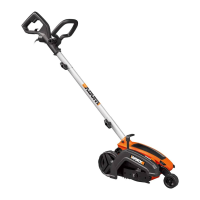7
IMPORTANT SAFETY
INSTRUCTIONS
WARNING: When using electric
gardening appliances, basic safety
precautions should always be followed to
reduce the risk of fire, electric shock, and
personal injury, including the following:
WARNING: Read all instructions
WARNING: Some dust created by
power sanding, sawing, grinding,
drilling and other construction activities
contains chemicals known to the state
of California to cause cancer, birth
defects or other reproductive harm.
Some examples of these chemicals are:
• Lead from lead-based paints;
• Crystalline silica from bricks and cement
and other masonry products
• Arsenic and chromium from chemically-
treated lumber.
Your risk from these exposures varies,
depending on how often you do this type
of work. To reduce your exposure to these
chemical: work in a well ventilated area,
and work with approved safety equipment,
such as those dust masks that are specially
designed to filter out microscopic particles.
WARNING: This product maybe
contains lead, phthalate or other
chemicals known to the State of
California to cause cancer, birth defects
and other reproductive harm. Please
wash your hands after use.
FOR ALL APPLIANCES
1) Avoid Dangerous Environment -
Don’t use appliances in damp or wet
locations.
2) Don’t Use In Rain.
3) Keep Children Away - All visitors
should be kept at a distance from work
area.
4) Dress Properly - Do not wear loose
clothing or jewelry. They can be
caught in moving parts. Use of rubber
gloves and substantial footwear is
recommended when working outdoors.
Wear protective hair covering to
contain long hair.
5) Use Safety Glasses - Always use face
or dust mask if operation is dusty.
6) Use Right Appliance - Do not use
appliance for any job except that for
which it is intended.
7) Ground Fault Circuit Interrupter
(GFCI) protection should be
provided on the circuit(s) or
outlet(s) to be used for the
gardening appliance. Receptacles are
available having built-in GFCI protection
and may be used for this measure of
safety.
8)
WARNING -To reduce the risk of
electric shock, use only with an
extension cord intended for outdoor
use, such as an extension cord of cord
type SW-A, SOW-A, STW-A, STOW-A,
SJW-A, SJOW-A, SJTW-A. or SJTOW-A.
9) Extension Cord - Make sure your
extension cord is in good condition.
When using an extension cord, be
sure to use one heavy enough to carry
the current your product will draw. An
undersized extension cord will cause a
drop in line voltage resulting in loss of
power and overheating. Table 1 shows
the correct size to use depending on
cord length and nameplate ampere
rating. If in doubt, use the next heavier
gage. The smaller the gage number, the
heavier the cord. To reduce the risk of
disconnection of appliance cord from
the extension cord during operating:
i) Make a knot as shown in Figure 1; or
ii) Use one of the plug-receptacle
retaining straps or connectors described
in this manual.
10) Avoid Unintentional Starting - Don’t
carry plugged-in appliance with finger
on switch. Be sure switch is off when
plugging in.
11) Don’t Abuse Cord - Never carry
appliance by cord or yank it to
disconnect from receptacle. Keep cord
from heat, oil, and sharp edges.

